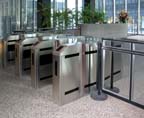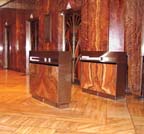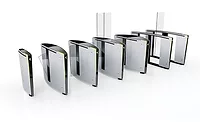Optical Turnstiles as a Portal

This is a fancy phrase for the locked door, released by a person to grant access to another into the controlled area for authorized personnel. Unfortunately, most access control systems use regular doors with locking devices to control access even though these units are extremely vulnerable to piggybacking, when an authorized cardholder holds open the door for someone they know, and tailgaters, or those who wait for an authorized card holder to open the door and then follow that person into the controlled area. Both piggybacking and tailgaters can compromise the integrity of a controlled environment.
Hence, we are always looking for something in the access control environment that will allow security to check every person, while at the same time be somewhat convenient to the employees, visitors, etc., who are required to use it.
One of the best devices that ensure system integrity by allowing only one person through at a time is the revolving door, but it may not always be the best choice of equipment for high-visibility applications that also require aesthetic compliance. Revolving doors can be very attractive, but work better in most instances for a perimeter application as opposed to an interior one. This led to the development of the optical turnstile.

Access objectives
Opticals achieve many objectives when they are properly applied. For example, they can provide:Lanes that control both access and egress – the capability of providing bi-directional travel on small applications using only one lane;
Easy integration with all card reader styles, biometric technologies, asset tracking technologies, and subsystems such as security video, duress and IDS;
The ability to ensure that each person is identified by either a card, biometric device or PIN when they come through the lanes; and
A formidable barrier if access must be halted.
The important thing to remember about the optical turnstile is the ability to utilize the technology in a variety of applications. For example, opticals can be purchased that:
Are simply open lanes that allow people to pass through without the use of barriers;
Can be supplied with “wing style” retractable barriers similar to what one would observe being used in transportation centers such as train stations; and
Are available with retractable glass barriers that can be installed as low glass (37 inches high), medium glass (42 inches) or high glass (67 inches) – each of which open and close with every transaction. The glass height is measured from about 3 inches above floor level, and the cabinet itself is about 42 inches high and mounts to the floor.
Only the lane employing a high-glass retractable barrier should be installed in applications where a security officer is not in the immediate area. If the optical is in a remote location, the use of subsystem technologies, such as security video for access transaction monitoring/recording and above-the-glass IDS devices, should be incorporated in case someone attempts to scale the glass barrier to gain entry into the facility. These technologies would be monitored at a centralized console with the ability to assess and deploy response personnel should something of this nature occur at a controlled access, optical turnstile portal.

Looks count
There is a wide selection of cabinet- and cabinet-top finishes from most of the manufacturers, and this is a feature that pleases many architectural types when they are first introduced to the optical unit as a security piece of equipment. Most architects like the flexibility of being able to select cabinet finishes to ensure aesthetic integrity of the project.Additional features include multiple arrays of photo-electric beams that detect tailgating or piggybacking, and that also have the ability to function as a safety device eliminating the barriers from closing on a person going through the lane. The important thing to remember as a maintenance requirement is that the glass ports through which the beams transmit and receive are kept clean and in alignment.
Pricing is always a factor in projects of this type, and while one cannot compare the price of an optical turnstile unit to a standard swinging door, especially when compared to the cost of an officer posted at the portal or the risk of unauthorized personnel entering the controlled area, the optical becomes quite competitive. Standard units that are either brushed aluminum or a painted finish supplied with high glass barriers will be normally priced between $20,000 to $25,000 per lane plus installation, shipment, etc. So if one designs and purchases a three-lane configuration, the cost could be as high as $60,000 to $75,000 for the equipment plus installation. This cost, compared with a security officer at a portal or acceptance of the previously mentioned risk factors of unauthorized entry, is very quickly offset. Most optical units, on a single-lane basis, will have a significant return on investment with a 12- to 18-month payout.
The optical turnstile unit is not the answer to everything, but it is a well-designed piece of equipment that should be in the end user’s arsenal of products to incorporate in a multi-technology integrated electronic security environment. They are generally easy to operate for the end user and capable of handling as many as 1,200 people per hour, per lane, when providing bi-directional services. Indicator lights will lead the person through the lane and if not accepted the barrier will not release or open, while at the same time alerting the security console to the incident.
When using opticals, many standard, access control requirements – such as ensuring that each card is read, the portal is controlled and a formidable barrier has been established – will be met. Additionally, the units can be attractive, easy to use, and very efficient as well as cost-effective.

Sidebar: Entrance Technology Gets Fancy
If you think about baseball parks and amusement parks when visualizing turnstiles, think again. Numerous vendors have deep lines of turnstiles to handle diverse applications. For example, Boon Edam Inc. of Salt Lake City, has pedestrian security barrier products including optical turnstiles, waist-high turnstiles, full-height turnstiles and swing gates to meet the growing demand for enhanced security entrances. Like the firm’s security doors and portals, these security barriers use technologies to allow only one authorized individual at a time to enter.Looking for a reprint of this article?
From high-res PDFs to custom plaques, order your copy today!






